Wesfarmers: Addressing Organisational Behaviour and Leadership
VerifiedAdded on 2024/06/05
|18
|3676
|296
Report
AI Summary
This report delves into the organisational behaviour and leadership dynamics within Wesfarmers, a prominent Australian company. It identifies a disconnect between strategic goals and operational execution, stemming from leadership disruptions and cultural challenges. The analysis covers issues such as workforce diversity, employee rights, and technology management. Applying theories like Herzberg's Two-Factor Theory, Fiedler's Contingency Theory, and Maslow's Hierarchy of Needs, the report explores potential solutions to improve employee satisfaction, productivity, and overall organisational effectiveness. Recommendations focus on enhancing communication, fostering a supportive work environment, and aligning leadership practices with the company's strategic objectives, all to ensure Wesfarmers' continued success and stability. Desklib provides students with access to a wide range of study tools, including solved assignments and past papers.
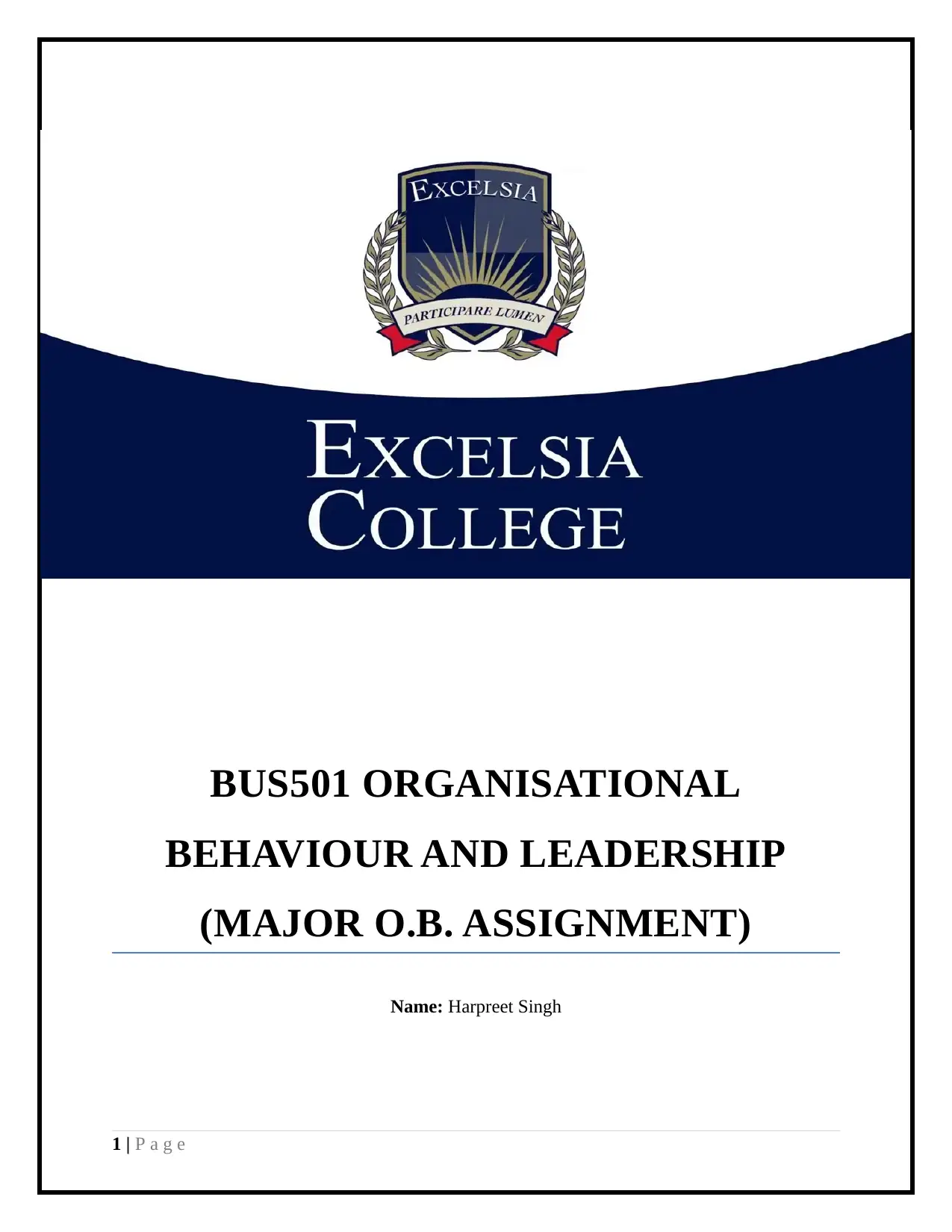
BUS501 ORGANISATIONAL
BEHAVIOUR AND LEADERSHIP
(MAJOR O.B. ASSIGNMENT)
Name: Harpreet Singh
1 | P a g e
BEHAVIOUR AND LEADERSHIP
(MAJOR O.B. ASSIGNMENT)
Name: Harpreet Singh
1 | P a g e
Paraphrase This Document
Need a fresh take? Get an instant paraphrase of this document with our AI Paraphraser
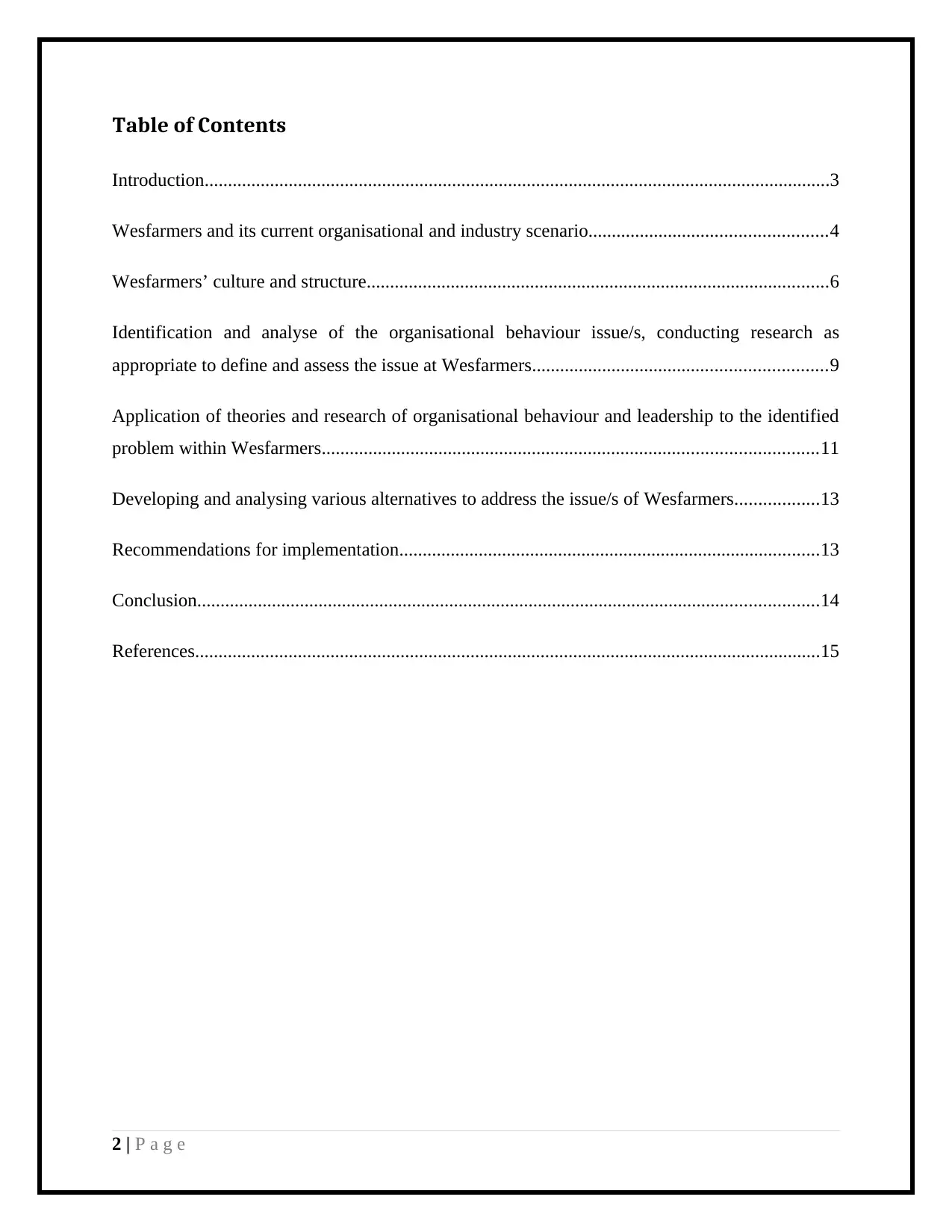
Table of Contents
Introduction......................................................................................................................................3
Wesfarmers and its current organisational and industry scenario...................................................4
Wesfarmers’ culture and structure...................................................................................................6
Identification and analyse of the organisational behaviour issue/s, conducting research as
appropriate to define and assess the issue at Wesfarmers...............................................................9
Application of theories and research of organisational behaviour and leadership to the identified
problem within Wesfarmers..........................................................................................................11
Developing and analysing various alternatives to address the issue/s of Wesfarmers..................13
Recommendations for implementation..........................................................................................13
Conclusion.....................................................................................................................................14
References......................................................................................................................................15
2 | P a g e
Introduction......................................................................................................................................3
Wesfarmers and its current organisational and industry scenario...................................................4
Wesfarmers’ culture and structure...................................................................................................6
Identification and analyse of the organisational behaviour issue/s, conducting research as
appropriate to define and assess the issue at Wesfarmers...............................................................9
Application of theories and research of organisational behaviour and leadership to the identified
problem within Wesfarmers..........................................................................................................11
Developing and analysing various alternatives to address the issue/s of Wesfarmers..................13
Recommendations for implementation..........................................................................................13
Conclusion.....................................................................................................................................14
References......................................................................................................................................15
2 | P a g e
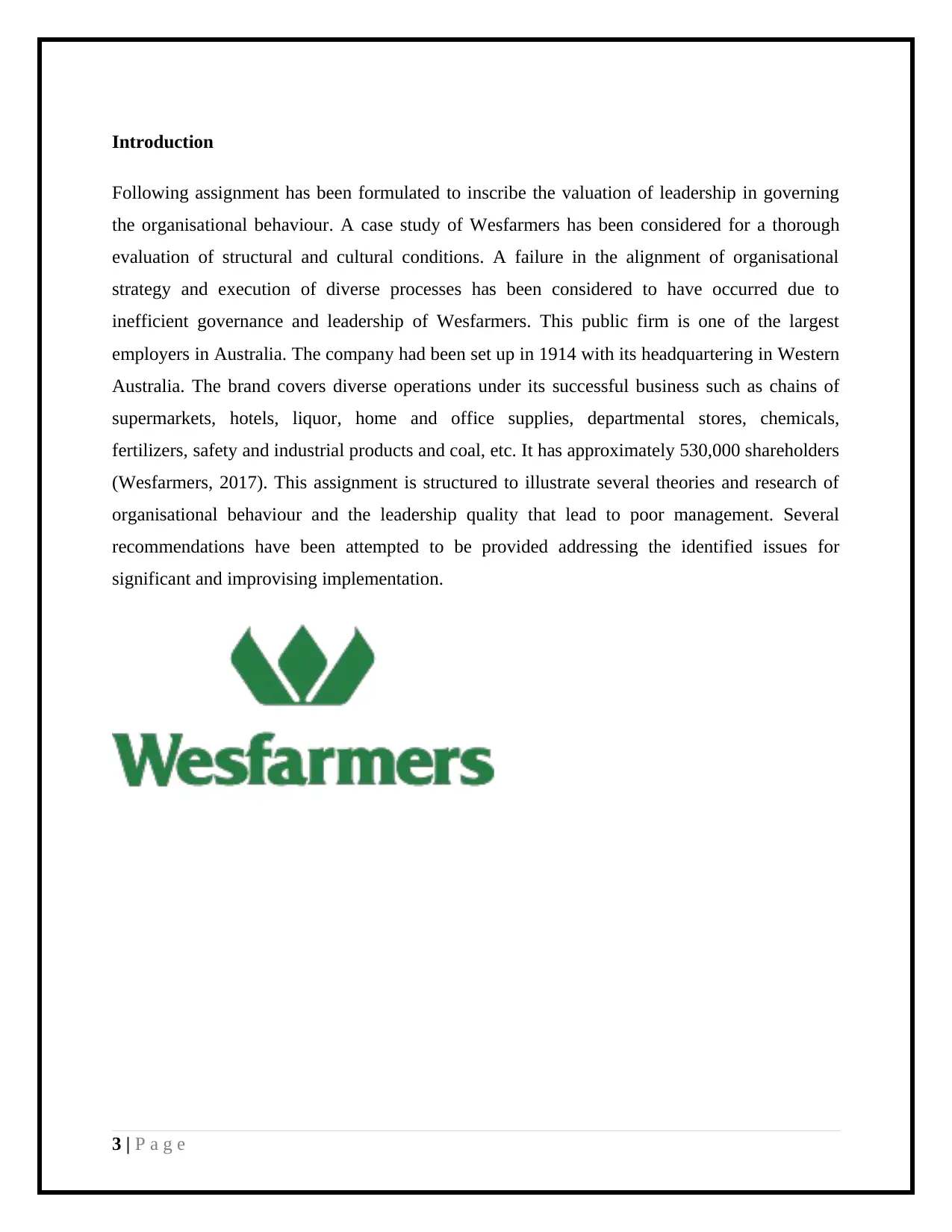
Introduction
Following assignment has been formulated to inscribe the valuation of leadership in governing
the organisational behaviour. A case study of Wesfarmers has been considered for a thorough
evaluation of structural and cultural conditions. A failure in the alignment of organisational
strategy and execution of diverse processes has been considered to have occurred due to
inefficient governance and leadership of Wesfarmers. This public firm is one of the largest
employers in Australia. The company had been set up in 1914 with its headquartering in Western
Australia. The brand covers diverse operations under its successful business such as chains of
supermarkets, hotels, liquor, home and office supplies, departmental stores, chemicals,
fertilizers, safety and industrial products and coal, etc. It has approximately 530,000 shareholders
(Wesfarmers, 2017). This assignment is structured to illustrate several theories and research of
organisational behaviour and the leadership quality that lead to poor management. Several
recommendations have been attempted to be provided addressing the identified issues for
significant and improvising implementation.
3 | P a g e
Following assignment has been formulated to inscribe the valuation of leadership in governing
the organisational behaviour. A case study of Wesfarmers has been considered for a thorough
evaluation of structural and cultural conditions. A failure in the alignment of organisational
strategy and execution of diverse processes has been considered to have occurred due to
inefficient governance and leadership of Wesfarmers. This public firm is one of the largest
employers in Australia. The company had been set up in 1914 with its headquartering in Western
Australia. The brand covers diverse operations under its successful business such as chains of
supermarkets, hotels, liquor, home and office supplies, departmental stores, chemicals,
fertilizers, safety and industrial products and coal, etc. It has approximately 530,000 shareholders
(Wesfarmers, 2017). This assignment is structured to illustrate several theories and research of
organisational behaviour and the leadership quality that lead to poor management. Several
recommendations have been attempted to be provided addressing the identified issues for
significant and improvising implementation.
3 | P a g e
⊘ This is a preview!⊘
Do you want full access?
Subscribe today to unlock all pages.

Trusted by 1+ million students worldwide
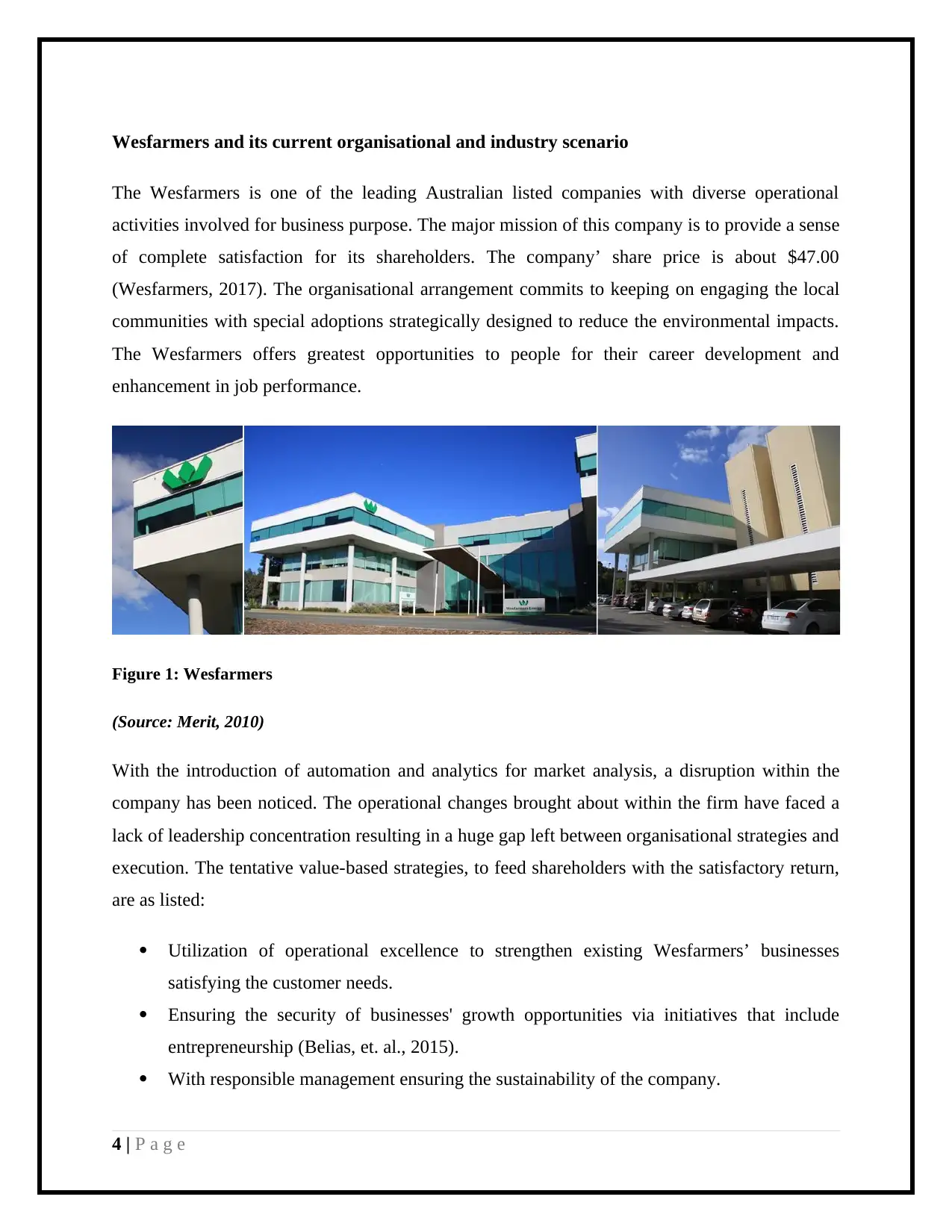
Wesfarmers and its current organisational and industry scenario
The Wesfarmers is one of the leading Australian listed companies with diverse operational
activities involved for business purpose. The major mission of this company is to provide a sense
of complete satisfaction for its shareholders. The company’ share price is about $47.00
(Wesfarmers, 2017). The organisational arrangement commits to keeping on engaging the local
communities with special adoptions strategically designed to reduce the environmental impacts.
The Wesfarmers offers greatest opportunities to people for their career development and
enhancement in job performance.
Figure 1: Wesfarmers
(Source: Merit, 2010)
With the introduction of automation and analytics for market analysis, a disruption within the
company has been noticed. The operational changes brought about within the firm have faced a
lack of leadership concentration resulting in a huge gap left between organisational strategies and
execution. The tentative value-based strategies, to feed shareholders with the satisfactory return,
are as listed:
Utilization of operational excellence to strengthen existing Wesfarmers’ businesses
satisfying the customer needs.
Ensuring the security of businesses' growth opportunities via initiatives that include
entrepreneurship (Belias, et. al., 2015).
With responsible management ensuring the sustainability of the company.
4 | P a g e
The Wesfarmers is one of the leading Australian listed companies with diverse operational
activities involved for business purpose. The major mission of this company is to provide a sense
of complete satisfaction for its shareholders. The company’ share price is about $47.00
(Wesfarmers, 2017). The organisational arrangement commits to keeping on engaging the local
communities with special adoptions strategically designed to reduce the environmental impacts.
The Wesfarmers offers greatest opportunities to people for their career development and
enhancement in job performance.
Figure 1: Wesfarmers
(Source: Merit, 2010)
With the introduction of automation and analytics for market analysis, a disruption within the
company has been noticed. The operational changes brought about within the firm have faced a
lack of leadership concentration resulting in a huge gap left between organisational strategies and
execution. The tentative value-based strategies, to feed shareholders with the satisfactory return,
are as listed:
Utilization of operational excellence to strengthen existing Wesfarmers’ businesses
satisfying the customer needs.
Ensuring the security of businesses' growth opportunities via initiatives that include
entrepreneurship (Belias, et. al., 2015).
With responsible management ensuring the sustainability of the company.
4 | P a g e
Paraphrase This Document
Need a fresh take? Get an instant paraphrase of this document with our AI Paraphraser
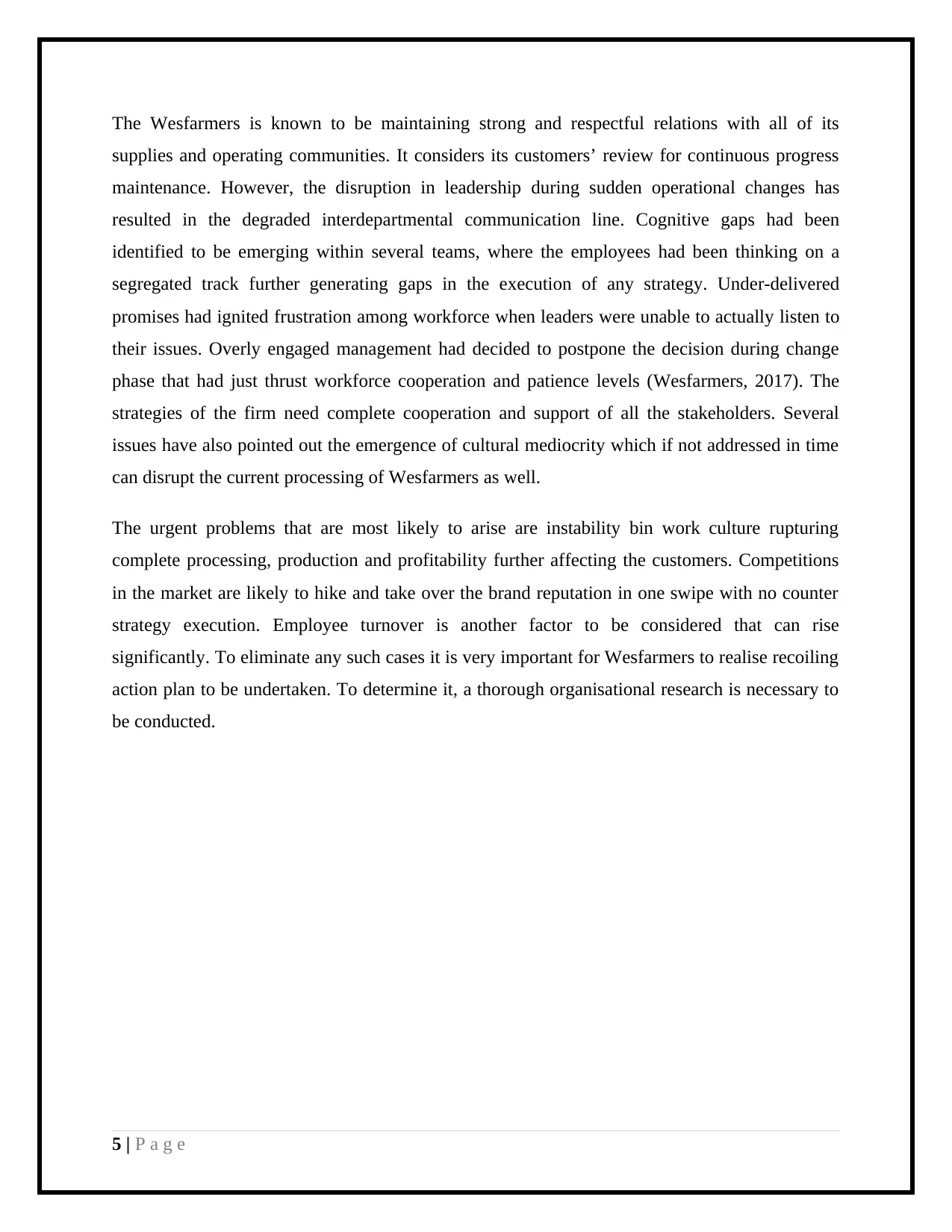
The Wesfarmers is known to be maintaining strong and respectful relations with all of its
supplies and operating communities. It considers its customers’ review for continuous progress
maintenance. However, the disruption in leadership during sudden operational changes has
resulted in the degraded interdepartmental communication line. Cognitive gaps had been
identified to be emerging within several teams, where the employees had been thinking on a
segregated track further generating gaps in the execution of any strategy. Under-delivered
promises had ignited frustration among workforce when leaders were unable to actually listen to
their issues. Overly engaged management had decided to postpone the decision during change
phase that had just thrust workforce cooperation and patience levels (Wesfarmers, 2017). The
strategies of the firm need complete cooperation and support of all the stakeholders. Several
issues have also pointed out the emergence of cultural mediocrity which if not addressed in time
can disrupt the current processing of Wesfarmers as well.
The urgent problems that are most likely to arise are instability bin work culture rupturing
complete processing, production and profitability further affecting the customers. Competitions
in the market are likely to hike and take over the brand reputation in one swipe with no counter
strategy execution. Employee turnover is another factor to be considered that can rise
significantly. To eliminate any such cases it is very important for Wesfarmers to realise recoiling
action plan to be undertaken. To determine it, a thorough organisational research is necessary to
be conducted.
5 | P a g e
supplies and operating communities. It considers its customers’ review for continuous progress
maintenance. However, the disruption in leadership during sudden operational changes has
resulted in the degraded interdepartmental communication line. Cognitive gaps had been
identified to be emerging within several teams, where the employees had been thinking on a
segregated track further generating gaps in the execution of any strategy. Under-delivered
promises had ignited frustration among workforce when leaders were unable to actually listen to
their issues. Overly engaged management had decided to postpone the decision during change
phase that had just thrust workforce cooperation and patience levels (Wesfarmers, 2017). The
strategies of the firm need complete cooperation and support of all the stakeholders. Several
issues have also pointed out the emergence of cultural mediocrity which if not addressed in time
can disrupt the current processing of Wesfarmers as well.
The urgent problems that are most likely to arise are instability bin work culture rupturing
complete processing, production and profitability further affecting the customers. Competitions
in the market are likely to hike and take over the brand reputation in one swipe with no counter
strategy execution. Employee turnover is another factor to be considered that can rise
significantly. To eliminate any such cases it is very important for Wesfarmers to realise recoiling
action plan to be undertaken. To determine it, a thorough organisational research is necessary to
be conducted.
5 | P a g e
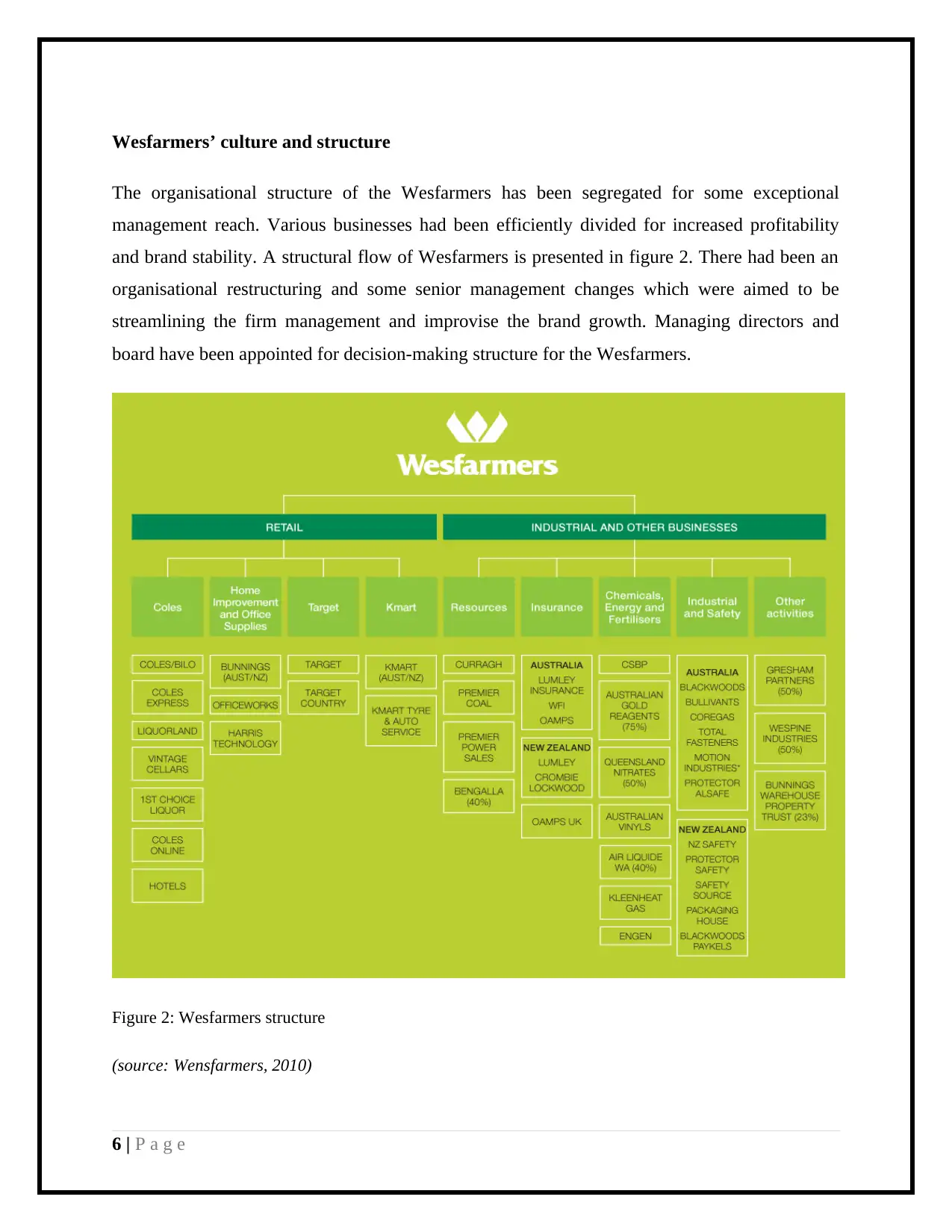
Wesfarmers’ culture and structure
The organisational structure of the Wesfarmers has been segregated for some exceptional
management reach. Various businesses had been efficiently divided for increased profitability
and brand stability. A structural flow of Wesfarmers is presented in figure 2. There had been an
organisational restructuring and some senior management changes which were aimed to be
streamlining the firm management and improvise the brand growth. Managing directors and
board have been appointed for decision-making structure for the Wesfarmers.
Figure 2: Wesfarmers structure
(source: Wensfarmers, 2010)
6 | P a g e
The organisational structure of the Wesfarmers has been segregated for some exceptional
management reach. Various businesses had been efficiently divided for increased profitability
and brand stability. A structural flow of Wesfarmers is presented in figure 2. There had been an
organisational restructuring and some senior management changes which were aimed to be
streamlining the firm management and improvise the brand growth. Managing directors and
board have been appointed for decision-making structure for the Wesfarmers.
Figure 2: Wesfarmers structure
(source: Wensfarmers, 2010)
6 | P a g e
⊘ This is a preview!⊘
Do you want full access?
Subscribe today to unlock all pages.

Trusted by 1+ million students worldwide
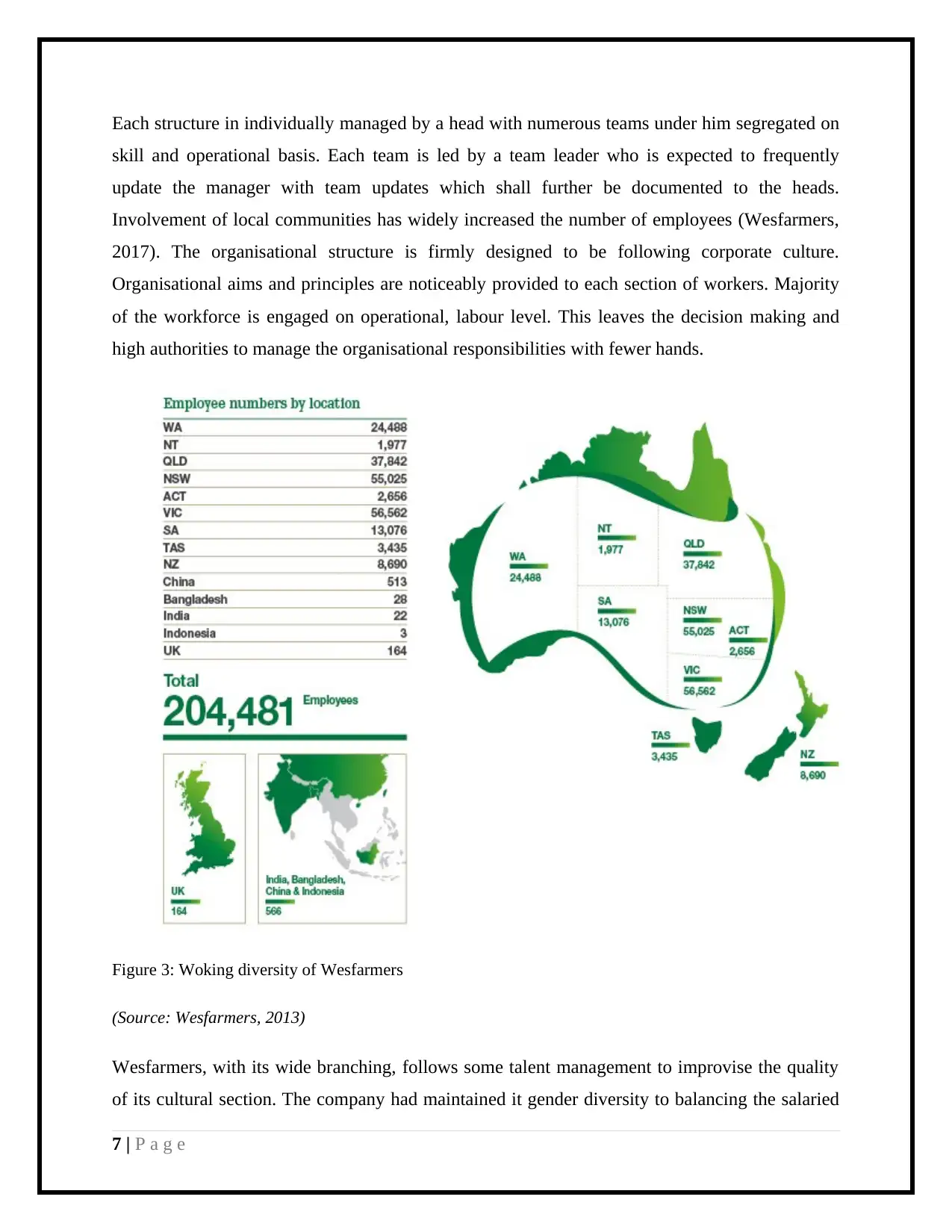
Each structure in individually managed by a head with numerous teams under him segregated on
skill and operational basis. Each team is led by a team leader who is expected to frequently
update the manager with team updates which shall further be documented to the heads.
Involvement of local communities has widely increased the number of employees (Wesfarmers,
2017). The organisational structure is firmly designed to be following corporate culture.
Organisational aims and principles are noticeably provided to each section of workers. Majority
of the workforce is engaged on operational, labour level. This leaves the decision making and
high authorities to manage the organisational responsibilities with fewer hands.
Figure 3: Woking diversity of Wesfarmers
(Source: Wesfarmers, 2013)
Wesfarmers, with its wide branching, follows some talent management to improvise the quality
of its cultural section. The company had maintained it gender diversity to balancing the salaried
7 | P a g e
skill and operational basis. Each team is led by a team leader who is expected to frequently
update the manager with team updates which shall further be documented to the heads.
Involvement of local communities has widely increased the number of employees (Wesfarmers,
2017). The organisational structure is firmly designed to be following corporate culture.
Organisational aims and principles are noticeably provided to each section of workers. Majority
of the workforce is engaged on operational, labour level. This leaves the decision making and
high authorities to manage the organisational responsibilities with fewer hands.
Figure 3: Woking diversity of Wesfarmers
(Source: Wesfarmers, 2013)
Wesfarmers, with its wide branching, follows some talent management to improvise the quality
of its cultural section. The company had maintained it gender diversity to balancing the salaried
7 | P a g e
Paraphrase This Document
Need a fresh take? Get an instant paraphrase of this document with our AI Paraphraser
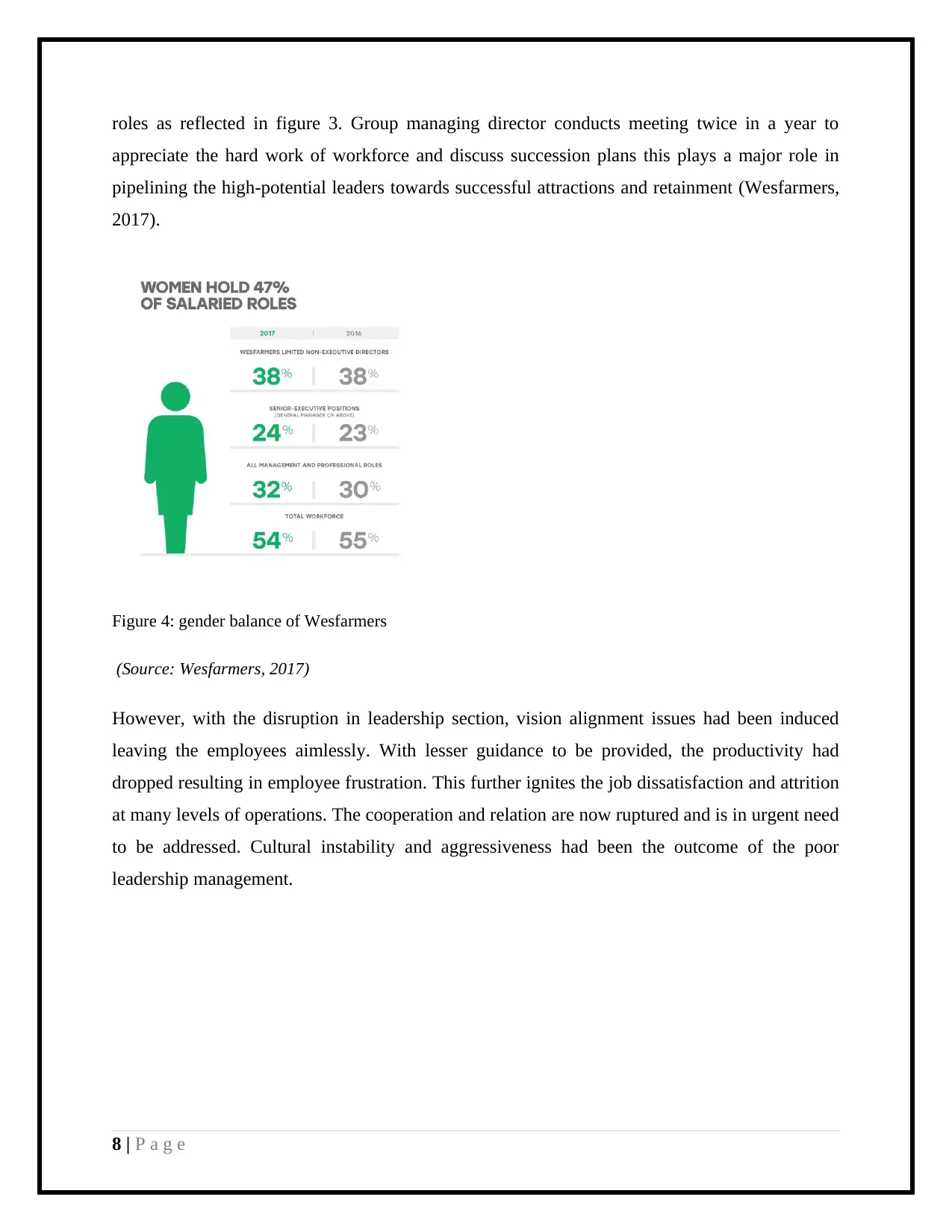
roles as reflected in figure 3. Group managing director conducts meeting twice in a year to
appreciate the hard work of workforce and discuss succession plans this plays a major role in
pipelining the high-potential leaders towards successful attractions and retainment (Wesfarmers,
2017).
Figure 4: gender balance of Wesfarmers
(Source: Wesfarmers, 2017)
However, with the disruption in leadership section, vision alignment issues had been induced
leaving the employees aimlessly. With lesser guidance to be provided, the productivity had
dropped resulting in employee frustration. This further ignites the job dissatisfaction and attrition
at many levels of operations. The cooperation and relation are now ruptured and is in urgent need
to be addressed. Cultural instability and aggressiveness had been the outcome of the poor
leadership management.
8 | P a g e
appreciate the hard work of workforce and discuss succession plans this plays a major role in
pipelining the high-potential leaders towards successful attractions and retainment (Wesfarmers,
2017).
Figure 4: gender balance of Wesfarmers
(Source: Wesfarmers, 2017)
However, with the disruption in leadership section, vision alignment issues had been induced
leaving the employees aimlessly. With lesser guidance to be provided, the productivity had
dropped resulting in employee frustration. This further ignites the job dissatisfaction and attrition
at many levels of operations. The cooperation and relation are now ruptured and is in urgent need
to be addressed. Cultural instability and aggressiveness had been the outcome of the poor
leadership management.
8 | P a g e
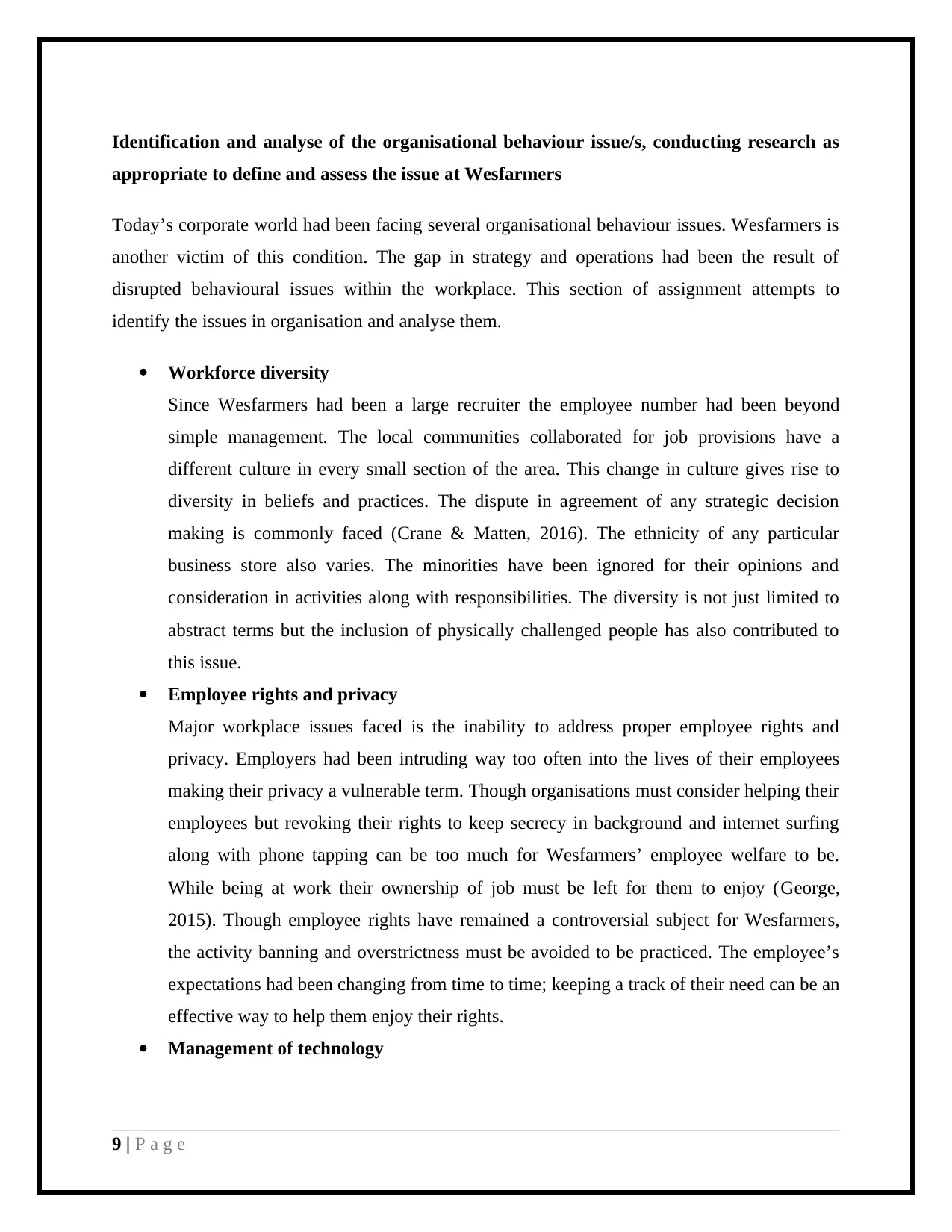
Identification and analyse of the organisational behaviour issue/s, conducting research as
appropriate to define and assess the issue at Wesfarmers
Today’s corporate world had been facing several organisational behaviour issues. Wesfarmers is
another victim of this condition. The gap in strategy and operations had been the result of
disrupted behavioural issues within the workplace. This section of assignment attempts to
identify the issues in organisation and analyse them.
Workforce diversity
Since Wesfarmers had been a large recruiter the employee number had been beyond
simple management. The local communities collaborated for job provisions have a
different culture in every small section of the area. This change in culture gives rise to
diversity in beliefs and practices. The dispute in agreement of any strategic decision
making is commonly faced (Crane & Matten, 2016). The ethnicity of any particular
business store also varies. The minorities have been ignored for their opinions and
consideration in activities along with responsibilities. The diversity is not just limited to
abstract terms but the inclusion of physically challenged people has also contributed to
this issue.
Employee rights and privacy
Major workplace issues faced is the inability to address proper employee rights and
privacy. Employers had been intruding way too often into the lives of their employees
making their privacy a vulnerable term. Though organisations must consider helping their
employees but revoking their rights to keep secrecy in background and internet surfing
along with phone tapping can be too much for Wesfarmers’ employee welfare to be.
While being at work their ownership of job must be left for them to enjoy (George,
2015). Though employee rights have remained a controversial subject for Wesfarmers,
the activity banning and overstrictness must be avoided to be practiced. The employee’s
expectations had been changing from time to time; keeping a track of their need can be an
effective way to help them enjoy their rights.
Management of technology
9 | P a g e
appropriate to define and assess the issue at Wesfarmers
Today’s corporate world had been facing several organisational behaviour issues. Wesfarmers is
another victim of this condition. The gap in strategy and operations had been the result of
disrupted behavioural issues within the workplace. This section of assignment attempts to
identify the issues in organisation and analyse them.
Workforce diversity
Since Wesfarmers had been a large recruiter the employee number had been beyond
simple management. The local communities collaborated for job provisions have a
different culture in every small section of the area. This change in culture gives rise to
diversity in beliefs and practices. The dispute in agreement of any strategic decision
making is commonly faced (Crane & Matten, 2016). The ethnicity of any particular
business store also varies. The minorities have been ignored for their opinions and
consideration in activities along with responsibilities. The diversity is not just limited to
abstract terms but the inclusion of physically challenged people has also contributed to
this issue.
Employee rights and privacy
Major workplace issues faced is the inability to address proper employee rights and
privacy. Employers had been intruding way too often into the lives of their employees
making their privacy a vulnerable term. Though organisations must consider helping their
employees but revoking their rights to keep secrecy in background and internet surfing
along with phone tapping can be too much for Wesfarmers’ employee welfare to be.
While being at work their ownership of job must be left for them to enjoy (George,
2015). Though employee rights have remained a controversial subject for Wesfarmers,
the activity banning and overstrictness must be avoided to be practiced. The employee’s
expectations had been changing from time to time; keeping a track of their need can be an
effective way to help them enjoy their rights.
Management of technology
9 | P a g e
⊘ This is a preview!⊘
Do you want full access?
Subscribe today to unlock all pages.

Trusted by 1+ million students worldwide
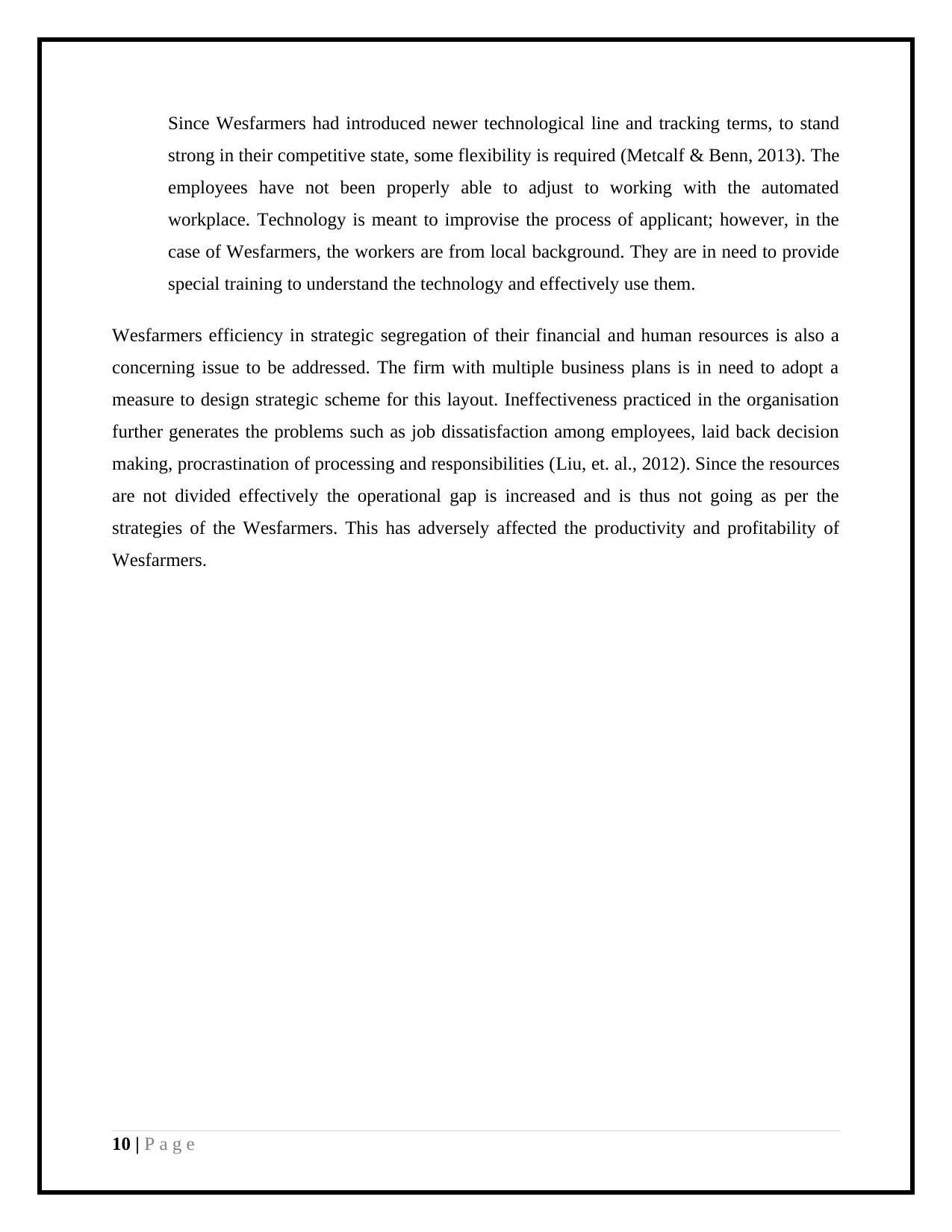
Since Wesfarmers had introduced newer technological line and tracking terms, to stand
strong in their competitive state, some flexibility is required (Metcalf & Benn, 2013). The
employees have not been properly able to adjust to working with the automated
workplace. Technology is meant to improvise the process of applicant; however, in the
case of Wesfarmers, the workers are from local background. They are in need to provide
special training to understand the technology and effectively use them.
Wesfarmers efficiency in strategic segregation of their financial and human resources is also a
concerning issue to be addressed. The firm with multiple business plans is in need to adopt a
measure to design strategic scheme for this layout. Ineffectiveness practiced in the organisation
further generates the problems such as job dissatisfaction among employees, laid back decision
making, procrastination of processing and responsibilities (Liu, et. al., 2012). Since the resources
are not divided effectively the operational gap is increased and is thus not going as per the
strategies of the Wesfarmers. This has adversely affected the productivity and profitability of
Wesfarmers.
10 | P a g e
strong in their competitive state, some flexibility is required (Metcalf & Benn, 2013). The
employees have not been properly able to adjust to working with the automated
workplace. Technology is meant to improvise the process of applicant; however, in the
case of Wesfarmers, the workers are from local background. They are in need to provide
special training to understand the technology and effectively use them.
Wesfarmers efficiency in strategic segregation of their financial and human resources is also a
concerning issue to be addressed. The firm with multiple business plans is in need to adopt a
measure to design strategic scheme for this layout. Ineffectiveness practiced in the organisation
further generates the problems such as job dissatisfaction among employees, laid back decision
making, procrastination of processing and responsibilities (Liu, et. al., 2012). Since the resources
are not divided effectively the operational gap is increased and is thus not going as per the
strategies of the Wesfarmers. This has adversely affected the productivity and profitability of
Wesfarmers.
10 | P a g e
Paraphrase This Document
Need a fresh take? Get an instant paraphrase of this document with our AI Paraphraser
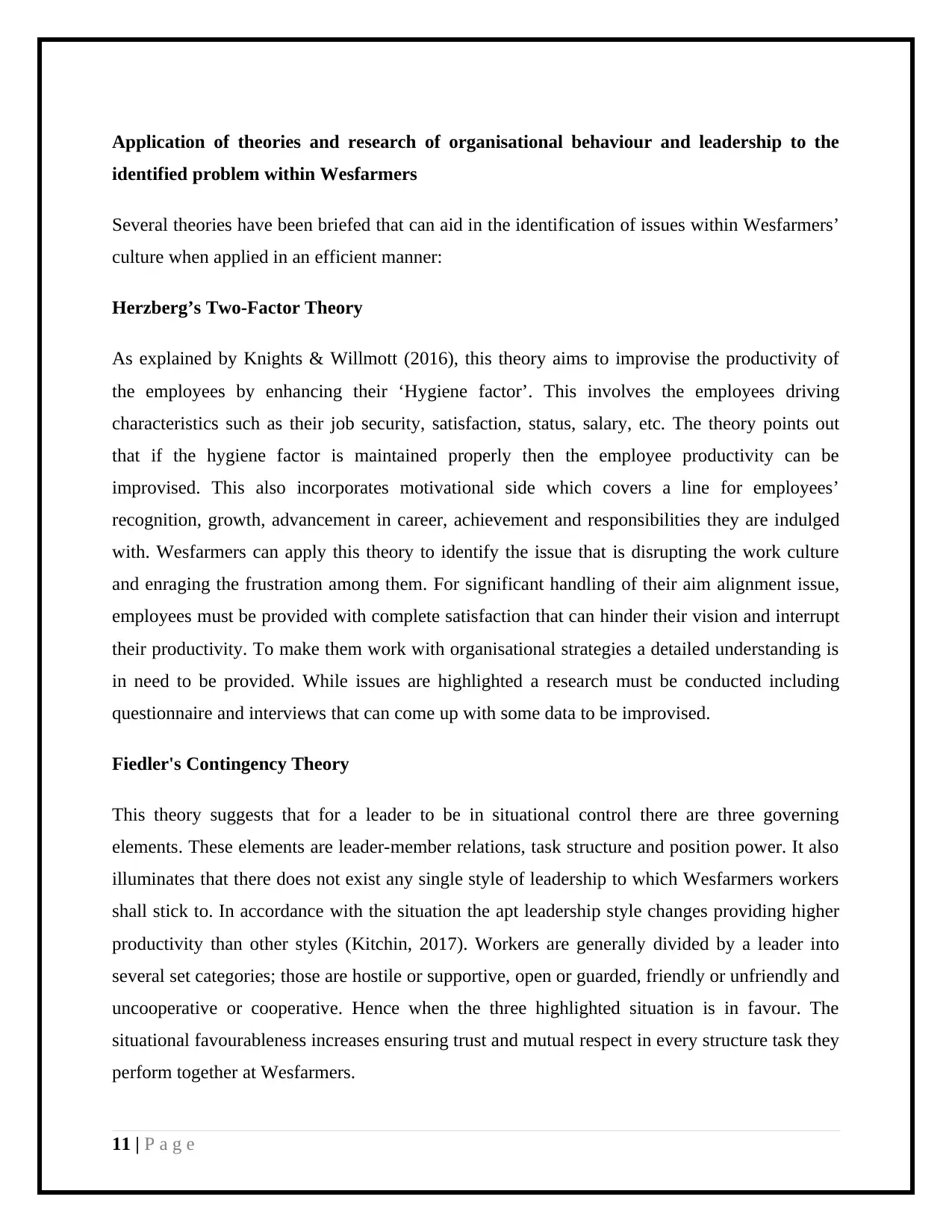
Application of theories and research of organisational behaviour and leadership to the
identified problem within Wesfarmers
Several theories have been briefed that can aid in the identification of issues within Wesfarmers’
culture when applied in an efficient manner:
Herzberg’s Two-Factor Theory
As explained by Knights & Willmott (2016), this theory aims to improvise the productivity of
the employees by enhancing their ‘Hygiene factor’. This involves the employees driving
characteristics such as their job security, satisfaction, status, salary, etc. The theory points out
that if the hygiene factor is maintained properly then the employee productivity can be
improvised. This also incorporates motivational side which covers a line for employees’
recognition, growth, advancement in career, achievement and responsibilities they are indulged
with. Wesfarmers can apply this theory to identify the issue that is disrupting the work culture
and enraging the frustration among them. For significant handling of their aim alignment issue,
employees must be provided with complete satisfaction that can hinder their vision and interrupt
their productivity. To make them work with organisational strategies a detailed understanding is
in need to be provided. While issues are highlighted a research must be conducted including
questionnaire and interviews that can come up with some data to be improvised.
Fiedler's Contingency Theory
This theory suggests that for a leader to be in situational control there are three governing
elements. These elements are leader-member relations, task structure and position power. It also
illuminates that there does not exist any single style of leadership to which Wesfarmers workers
shall stick to. In accordance with the situation the apt leadership style changes providing higher
productivity than other styles (Kitchin, 2017). Workers are generally divided by a leader into
several set categories; those are hostile or supportive, open or guarded, friendly or unfriendly and
uncooperative or cooperative. Hence when the three highlighted situation is in favour. The
situational favourableness increases ensuring trust and mutual respect in every structure task they
perform together at Wesfarmers.
11 | P a g e
identified problem within Wesfarmers
Several theories have been briefed that can aid in the identification of issues within Wesfarmers’
culture when applied in an efficient manner:
Herzberg’s Two-Factor Theory
As explained by Knights & Willmott (2016), this theory aims to improvise the productivity of
the employees by enhancing their ‘Hygiene factor’. This involves the employees driving
characteristics such as their job security, satisfaction, status, salary, etc. The theory points out
that if the hygiene factor is maintained properly then the employee productivity can be
improvised. This also incorporates motivational side which covers a line for employees’
recognition, growth, advancement in career, achievement and responsibilities they are indulged
with. Wesfarmers can apply this theory to identify the issue that is disrupting the work culture
and enraging the frustration among them. For significant handling of their aim alignment issue,
employees must be provided with complete satisfaction that can hinder their vision and interrupt
their productivity. To make them work with organisational strategies a detailed understanding is
in need to be provided. While issues are highlighted a research must be conducted including
questionnaire and interviews that can come up with some data to be improvised.
Fiedler's Contingency Theory
This theory suggests that for a leader to be in situational control there are three governing
elements. These elements are leader-member relations, task structure and position power. It also
illuminates that there does not exist any single style of leadership to which Wesfarmers workers
shall stick to. In accordance with the situation the apt leadership style changes providing higher
productivity than other styles (Kitchin, 2017). Workers are generally divided by a leader into
several set categories; those are hostile or supportive, open or guarded, friendly or unfriendly and
uncooperative or cooperative. Hence when the three highlighted situation is in favour. The
situational favourableness increases ensuring trust and mutual respect in every structure task they
perform together at Wesfarmers.
11 | P a g e
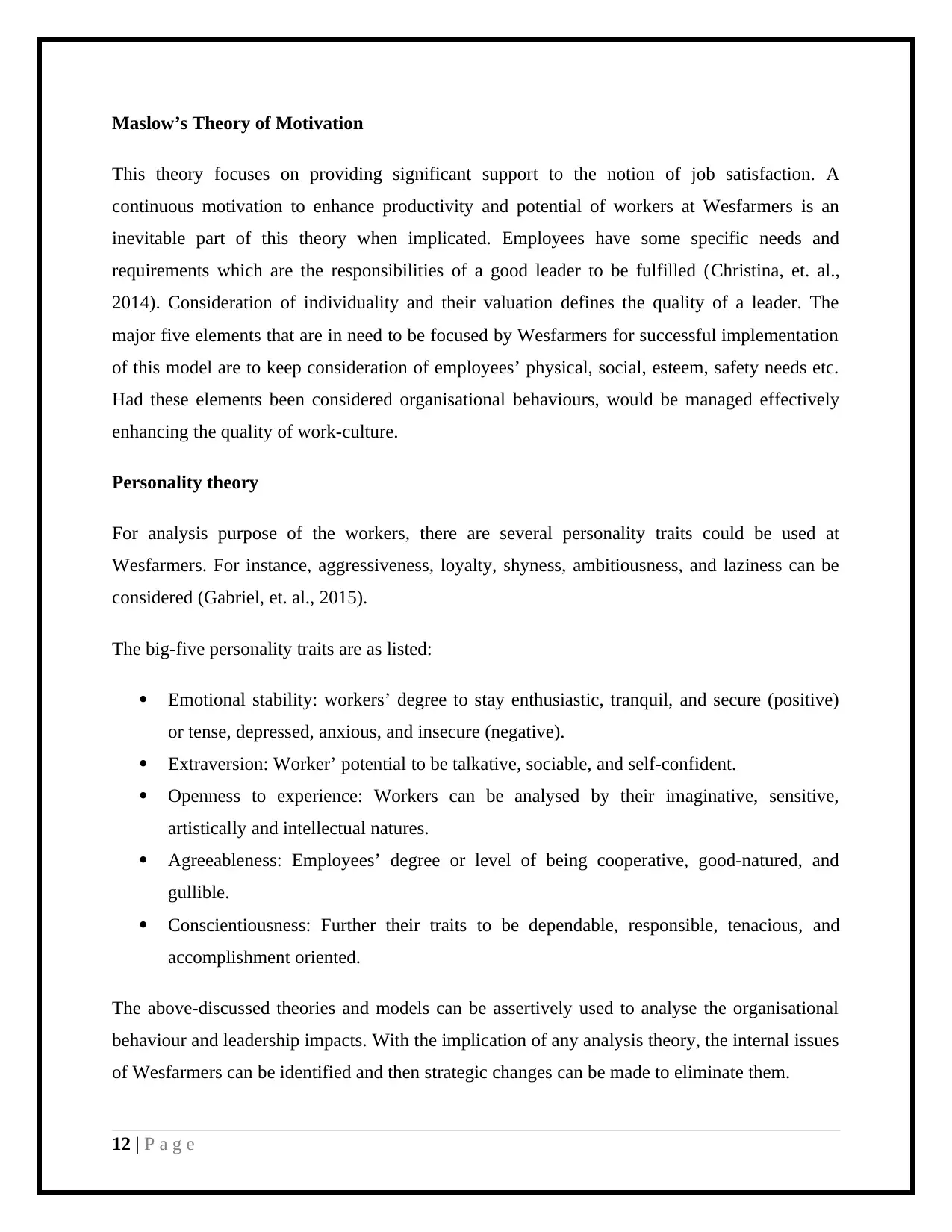
Maslow’s Theory of Motivation
This theory focuses on providing significant support to the notion of job satisfaction. A
continuous motivation to enhance productivity and potential of workers at Wesfarmers is an
inevitable part of this theory when implicated. Employees have some specific needs and
requirements which are the responsibilities of a good leader to be fulfilled (Christina, et. al.,
2014). Consideration of individuality and their valuation defines the quality of a leader. The
major five elements that are in need to be focused by Wesfarmers for successful implementation
of this model are to keep consideration of employees’ physical, social, esteem, safety needs etc.
Had these elements been considered organisational behaviours, would be managed effectively
enhancing the quality of work-culture.
Personality theory
For analysis purpose of the workers, there are several personality traits could be used at
Wesfarmers. For instance, aggressiveness, loyalty, shyness, ambitiousness, and laziness can be
considered (Gabriel, et. al., 2015).
The big-five personality traits are as listed:
Emotional stability: workers’ degree to stay enthusiastic, tranquil, and secure (positive)
or tense, depressed, anxious, and insecure (negative).
Extraversion: Worker’ potential to be talkative, sociable, and self-confident.
Openness to experience: Workers can be analysed by their imaginative, sensitive,
artistically and intellectual natures.
Agreeableness: Employees’ degree or level of being cooperative, good-natured, and
gullible.
Conscientiousness: Further their traits to be dependable, responsible, tenacious, and
accomplishment oriented.
The above-discussed theories and models can be assertively used to analyse the organisational
behaviour and leadership impacts. With the implication of any analysis theory, the internal issues
of Wesfarmers can be identified and then strategic changes can be made to eliminate them.
12 | P a g e
This theory focuses on providing significant support to the notion of job satisfaction. A
continuous motivation to enhance productivity and potential of workers at Wesfarmers is an
inevitable part of this theory when implicated. Employees have some specific needs and
requirements which are the responsibilities of a good leader to be fulfilled (Christina, et. al.,
2014). Consideration of individuality and their valuation defines the quality of a leader. The
major five elements that are in need to be focused by Wesfarmers for successful implementation
of this model are to keep consideration of employees’ physical, social, esteem, safety needs etc.
Had these elements been considered organisational behaviours, would be managed effectively
enhancing the quality of work-culture.
Personality theory
For analysis purpose of the workers, there are several personality traits could be used at
Wesfarmers. For instance, aggressiveness, loyalty, shyness, ambitiousness, and laziness can be
considered (Gabriel, et. al., 2015).
The big-five personality traits are as listed:
Emotional stability: workers’ degree to stay enthusiastic, tranquil, and secure (positive)
or tense, depressed, anxious, and insecure (negative).
Extraversion: Worker’ potential to be talkative, sociable, and self-confident.
Openness to experience: Workers can be analysed by their imaginative, sensitive,
artistically and intellectual natures.
Agreeableness: Employees’ degree or level of being cooperative, good-natured, and
gullible.
Conscientiousness: Further their traits to be dependable, responsible, tenacious, and
accomplishment oriented.
The above-discussed theories and models can be assertively used to analyse the organisational
behaviour and leadership impacts. With the implication of any analysis theory, the internal issues
of Wesfarmers can be identified and then strategic changes can be made to eliminate them.
12 | P a g e
⊘ This is a preview!⊘
Do you want full access?
Subscribe today to unlock all pages.

Trusted by 1+ million students worldwide
1 out of 18
Related Documents
Your All-in-One AI-Powered Toolkit for Academic Success.
+13062052269
info@desklib.com
Available 24*7 on WhatsApp / Email
![[object Object]](/_next/static/media/star-bottom.7253800d.svg)
Unlock your academic potential
Copyright © 2020–2025 A2Z Services. All Rights Reserved. Developed and managed by ZUCOL.





